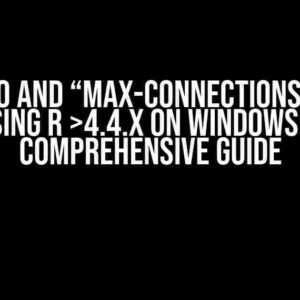Are you tired of being limited by the graphical interface of AnyLogic? Do you want to unlock the full potential of your simulation models by integrating them with the power of command-line tools? Look no further! In this comprehensive guide, we’ll show you how to call command-line from within AnyLogic, empowering you to automate tasks, leverage system resources, and take your modeling skills to the next level.
Why Call Command-Line from Within AnyLogic?
AnyLogic is an incredibly powerful simulation modeling tool, but it’s not a one-stop-shop for every task. Sometimes, you need to tap into the vast array of command-line tools available to perform specific tasks, such as:
- Data processing and analysis
- File management and manipulation
- System integration and automation
- Custom script execution
By calling command-line from within AnyLogic, you can bridge the gap between your simulation models and the command-line ecosystem, opening up new possibilities for automation, customization, and innovation.
Prerequisites and Setup
Before we dive into the nitty-gritty, make sure you have the following:
- AnyLogic 8.5 or later installed on your system
- A basic understanding of Java programming (don’t worry, we’ll keep it simple!)
- A command-line tool or script you want to integrate with AnyLogic
For this example, we’ll use the Windows operating system and the calc command-line tool, which is a simple calculator program. You can substitute this with any command-line tool or script you like.
Method 1: Using the Runtime.exec() Method
This method involves using the Runtime.exec() method in Java to execute an external command-line program. We’ll create a simple Java class within AnyLogic to demonstrate this.
public class CommandLineCaller {
public void callCalc() {
try {
Runtime rt = Runtime.getRuntime();
Process pr = rt.exec("calc");
pr.waitFor();
} catch (IOException | InterruptedException e) {
System.out.println("Error: " + e.getMessage());
}
}
}
In this example, we create a Java class called CommandLineCaller with a single method callCalc(). This method uses the Runtime.exec() method to execute the calc command-line tool. The waitFor() method is used to wait for the process to finish.
Integrating the Java Class with AnyLogic
To use this Java class within AnyLogic, we’ll create a new simulation model and add a Java action to the model.
- Create a new simulation model in AnyLogic
- Add a new Java action to the model by right-clicking on the model element and selecting “Java action”
- Paste the Java code into the Java action editor
- Compile the Java class by clicking the “Compile” button
Now, when you run the simulation model, the Java action will execute the calc command-line tool.
Method 2: Using the ProcessBuilder Class
This method involves using the ProcessBuilder class in Java to execute an external command-line program. We’ll create another Java class within AnyLogic to demonstrate this.
public class CommandLineCaller {
public void callCalc() {
try {
ProcessBuilder pb = new ProcessBuilder("calc");
Process pr = pb.start();
pr.waitFor();
} catch (IOException | InterruptedException e) {
System.out.println("Error: " + e.getMessage());
}
}
}
In this example, we create a Java class called CommandLineCaller with a single method callCalc(). This method uses the ProcessBuilder class to execute the calc command-line tool. The start() method is used to start the process, and the waitFor() method is used to wait for the process to finish.
Passing Arguments to the Command-Line Tool
Sometimes, you need to pass arguments to the command-line tool to customize its behavior. We can do this by modifying the ProcessBuilder class to accept arguments.
public class CommandLineCaller {
public void callCalc(String argument) {
try {
ProcessBuilder pb = new ProcessBuilder("calc", argument);
Process pr = pb.start();
pr.waitFor();
} catch (IOException | InterruptedException e) {
System.out.println("Error: " + e.getMessage());
}
}
}
In this example, we modify the callCalc() method to accept a string argument, which is passed to the ProcessBuilder constructor along with the command-line tool name. This allows us to pass custom arguments to the command-line tool.
Common Issues and Troubleshooting
When calling command-line from within AnyLogic, you may encounter some common issues:
- Permissions issues: Ensure that the command-line tool has the necessary permissions to execute.
- Path issues: Make sure the command-line tool is in the system’s PATH environment variable or provide the full path to the tool.
- Argument issues: Verify that the arguments are correctly formatted and passed to the command-line tool.
To troubleshoot these issues, use the following techniques:
- Check the Java console output for error messages
- Use the
System.out.println()method to debug the Java code - Verify the command-line tool’s syntax and usage
| Command-Line Tool | AnyLogic Method |
|---|---|
calc |
Calling the calc command-line tool from within AnyLogic |
dir |
Listing directory contents using the dir command-line tool |
python |
Executing a Python script using the python command-line tool |
In this table, we’ve listed some common command-line tools that can be called from within AnyLogic, along with a brief description of their usage.
Conclusion
Calling command-line from within AnyLogic is a powerful technique that can unlock new possibilities for automation, customization, and innovation in your simulation models. By following the steps outlined in this guide, you can integrate AnyLogic with the vast array of command-line tools available, taking your modeling skills to the next level.
Remember to experiment with different command-line tools and scripts to discover new ways of leveraging their power within AnyLogic. With practice and creativity, the possibilities are endless!
Happy modeling!
Frequently Asked Question
Get answers to the most frequently asked questions about calling command-line from within AnyLogic.
How can I call a command-line from within AnyLogic?
You can use the `Runtime.exec()` method in Java to call a command-line from within AnyLogic. This method allows you to execute a specific command in a separate process. For example, you can use it to run a Python script, execute a shell command, or start an external application.
What is the syntax to call a command-line from within AnyLogic?
The basic syntax to call a command-line from within AnyLogic is `Runtime.getRuntime().exec(command)`, where `command` is the command you want to execute. For example, if you want to run a Python script, the command would be `Runtime.getRuntime().exec(“python script.py”)`. Make sure to replace `script.py` with the actual path and name of your script.
Can I pass arguments to the command-line from within AnyLogic?
Yes, you can pass arguments to the command-line from within AnyLogic by including them in the command string. For example, if you want to pass the argument `input.txt` to your Python script, the command would be `Runtime.getRuntime().exec(“python script.py input.txt”)`. You can separate multiple arguments with spaces.
How can I capture the output of the command-line from within AnyLogic?
You can capture the output of the command-line from within AnyLogic by using the `Process` object returned by the `exec()` method. You can read the output from the process’s input stream using a `BufferedReader` and a `StringBufer`. For example, `BufferedReader reader = new BufferedReader(new InputStreamReader(process.getInputStream()));` and then read the output line by line using `reader.readLine()`.
Are there any limitations or considerations when calling command-line from within AnyLogic?
Yes, there are some limitations and considerations when calling command-line from within AnyLogic. For example, the command-line process runs in a separate thread, so you need to ensure that it doesn’t block the main thread. Additionally, you need to handle potential errors and exceptions that may occur during the execution of the command. It’s also important to consider security and performance implications when executing external commands from within your model.




